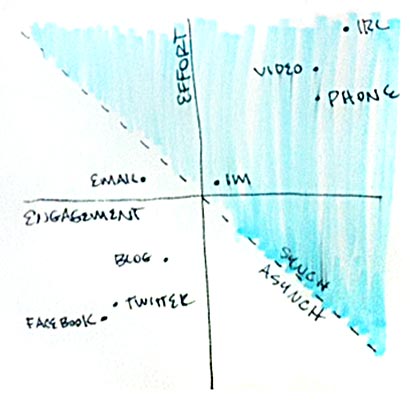Small Talk: a communication guide for geeks

This post is a response to Tantek Çelic’s article on communication protocols. I agree with most all of it, except the bit about IM protocol.
Depending on the mindset of whomever you ask, small talk is either the foundation of a good conversation or annoying prattle to be minimized as much as possible. I find the latter opinion to be often held by highly systematic thinkers who find communication to be stressful.
You can see this reluctance to jump into a conversation without small talk by listening to a radio call in show. When a caller is put on air, it takes them a second to collect themselves and launch into their thought. They often want to go through the usual rituals of starting a conversation, saying hello and complimenting the host. Even though the handlers have coached guests to get straight to the point, the hosts often have to prompt the guest again with “what’s your question.” The pressure is on to be as efficient in communication as possible, but most people fail because we’re socialized to preface our conversations.
The most efficient from the point of view of not using small talk are toddlers. They blurt out their requests without regard to whether the caregiver is listening or not. Through patient effort, they are socialized to request an audience first. This has its own difficult stage as the toddler repeats that request “mommy, mommy, mommy…” ad nauseum.
Fortunately we (mostly) all make it past these stages with proper adult manners to first request someone’s attention. Their response allows us judge the person’s mood and level of engagement so we may adjust our communication style.
Greetings and small talk persist beyond face to face and voice-only communication. Letters must include greeting to conform to ettiquete.
Direct message (DM) and text messaging (txt) aren’t subject to these etiquette rules because they are asynchronous.
Instant message (IM) is as close to synchronous conversation as we have in the text-based communication world. It’s close enough to a phone conversation that we often query to see if the person is there before launching into the conversation. It’s similar to making the phone ring. That’s why people say things like “psst,” “ping,” “u there,” or “hello?” as their first message.
To those of you who are annoyed by these greetings, keep in mind that the majority of folks find jumping right into a conversation rude. Please don’t inflict your Aspergers on the rest of us. Yes, etiquette changes to adapt to new technology, but I suspect this won’t be changing any time soon. All of the people who I would classify as exceptional communicators start off with a request for audience. Consider how you might respond in a way that will help the other person adjust their expectation of how much of your time and attention you have available for them.